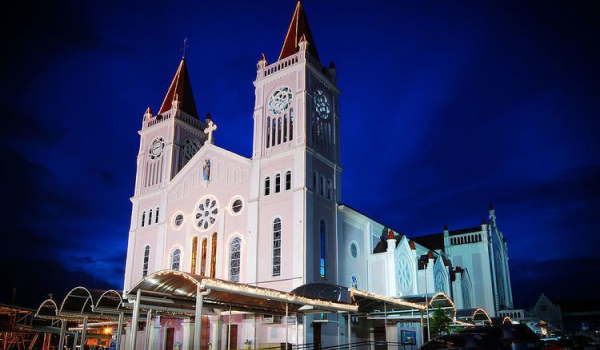
In a land area of 2,655 square kilometers, the diocesan territory covers Baguio City and Benguet Province.
Baguio City is landlocked within the province of Benguet, thus bounding it on all sides by its different municipalities; on the North by the capital town of La Trinidad, on the East by Itogon and to the South and West by Tuba.
Benguet is a landlocked province of the Philippines in the Cordillera Administrative Region (CAR) in Luzon. Its capital is La Trinidad and borders, clockwise from the south, Pangasinan, La Union, Ilocos Sur, Mountain Province, Ifugao, and Nueva Vizcaya.
A total of 13 municipalities and 140 barangays (villages) make up the province, while Baguio City is politically subdivided into 129 barangays.
As of year end 2018 the total population of the diocese is 776,640 of which 72.60 percent are Catholics or 563,890.
Evidences of at least two series of waves and periods of migration in northern Luzon. The migrants were similar in physical type and language but came from different localities in southeastern Asia where they developed their own organizations and institutions that they brought to Luzon and modified in their new habitat.
The first series includes the Igorot; the Ibaloi of Benguet, the Kankanai of Lepanto, the Bontoks, and the Ifugaos. They have the following institutions in common: "trial marriage; division of their settlements into social and political units known as ato; separate dormitories for unmarried men and women; government by the federated divisions of a village as represented by old men; and a peculiar and characteristic type of dwelling.
In the second wave series belong to the Ilocanos, the Tinguians (Itnegs or Isnegs), the Apayaos, and the western Kalingas, to whom the institutions of the first wave series are unknown.
The languages commonly spoken in Baguio are Kankana-ey, Ibaloi, Ilocano, Ifugo, Tagalog, Kapampangan, Pangasinan, English, Chinese, and recently, Korean - due to a significantly large number of Korean students who are coming to the city to study the English language.
DIOCESE OF BAGUIO
(Baghiopolitana)
Suffragan of Nueva Segovia
Created Apostolic Prelature of the Mountain Provinces on July 15, 1932
Created Apostolic Vicariate of Metropolitan Baguio by division on July 6, 1992
Elevated to the status of a Diocese on July 10, 2004
Comprising Baguio City and Benguet Province
Titular: Immaculate Heart of Mary
Diocese of Baguio was created July 6, 1932 from the then Apostolic Vicariate of the Mountain Provinces. Baguio City within the province of Benguet is sometimes called Pines City because of its picturesque forests of Benguet Pine. It sits on a plateau in the central Cordillera Mountains, with an elevation of 1,524 meters. And with the rest of Benguet, enjoys cool temperatures in January and in May. It is the summer capital of the country.
It was created Apostolic Vicariate of Metropolitan Baguio by division on July 6, 1992 and was elevated to the status of a Diocese on July 10, 2004.
Evangelization in the area was started in 1907 by the pioneer missionaries of the Congregation of the Immaculate Heart of Mary (CICM), also known as the Scheut Fathers. These missionaries established mission centers, Catholic schools, a hospital and a clinic. Today the work of evangelization is being carried out through a network of 8 parishes in Baguio and 13 mission stations in the district of Benguet.
Formerly under the Archdiocese of Nueva Segovia, created Apostolic Prelature of the Mountain Provinces (MONTAÑOSA) on July 15, 1932. It was elevated to Apostolic Vicariate on June 10, 1948 with Bishop William Brasseur, CICM, as the first Apostolic Vicar of Montañosa.
On Dec. 22, 2001 Most Rev. Carlito Cenzon, CICM, DD was appointed as the second apostolic vicar and on July 10, 2004 he was appointed the first bishop of the Diocese of Baguio.
Baguio City's lone congressional district is currently represented in the House of Representatives of the Philippines. Like most Philippine cities, Baguio is governed by a Mayor, Vice Mayor, and twelve (12) Councilors. However, being a highly-urbanized city, it is not subject to the jurisdiction of Benguet, the province which it was formerly part of. Baguio is the seat of government of the Cordillera Administrative Region
Literacy rate (simple literacy; including Baguio City) is 91.15 percent.